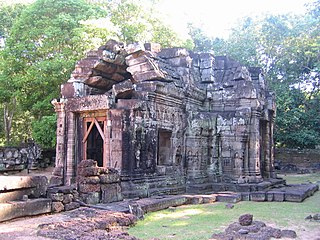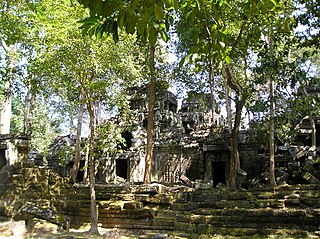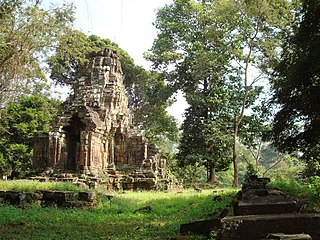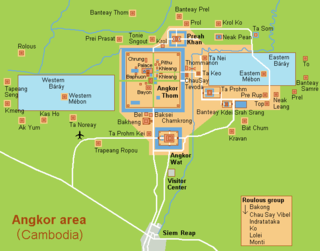
In Khmer architecture, the period of Angkor is the period in the history of the Khmer Empire from approximately the later half of the 8th century CE to the first half of the 15th century CE.

The Khmer Empire, officially the Angkor Empire, the predecessor state to modern Cambodia, was a Hindu-Buddhist empire in Southeast Asia. The empire, which grew out of the former kingdoms of Funan and Chenla, at times ruled over and/or vassalised most of mainland Southeast Asia and parts of Southern China, stretching from the tip of the Indochinese Peninsula northward to modern Yunnan province, China, and from Vietnam westward to Myanmar.

Ta Prohm is the modern name of the temple at Angkor, Siem Reap Province, Cambodia, built in the Bayon style largely in the late 12th and early 13th centuries and originally called Rajavihara. Located approximately one kilometre east of Angkor Thom and on the southern edge of the East Baray, it was founded by the Khmer King Jayavarman VII as a Mahayana Buddhist monastery and university. Unlike most Angkorian temples, Ta Prohm is in much the same condition in which it was found: the photogenic and atmospheric combination of trees growing out of the ruins and the jungle surroundings have made it one of Angkor's most popular temples with visitors. UNESCO inscribed Ta Prohm on the World Heritage List in 1992. Today, it is one of the most visited complexes in Cambodia’s Angkor region. The conservation and restoration of Ta Prohm is a partnership project of the Archaeological Survey of India and the APSARA.

Ta Keo is a temple-mountain in Angkor (Cambodia), possibly the first to be built entirely of sandstone by Khmers.

Banteay Kdei, meaning "A Citadel of Chambers", also known as "Citadel of Monks' cells", is a Buddhist temple in Angkor, Cambodia. It is located southeast of Ta Prohm and east of Angkor Thom. Built in the mid-12th to early 13th centuries AD during the reign of Jayavarman VII, it is in the Bayon architectural style, similar in plan to Ta Prohm and Preah Khan, but less complex and smaller. Its structures are contained within two successive enclosure walls, and consist of two concentric galleries from which emerge towers, preceded to the east by a cloister.

Thommanon is one of a pair of Hindu temples built during the reign of Suryavarman II (1113–1150) at Angkor, Cambodia. This small and elegant temple is east of the Gate of Victory of Angkor Thom and north of Chau Say Tevoda. It is part of the UNESCO World Heritage Site, inscribed by UNESCO in 1992 titled Angkor. The temple is dedicated to Shiva and Vishnu.

Preah Khan is a temple at Angkor, Cambodia, built in the 12th century for King Jayavarman VII to honor his father. It is located northeast of Angkor Thom and just west of the Jayatataka baray, with which it was associated. It was the centre of a substantial organisation, with almost 100,000 officials and servants. The temple is flat in design, with a basic plan of successive rectangular galleries around a Buddhist sanctuary complicated by Hindu satellite temples and numerous later additions. Like the nearby Ta Prohm, Preah Khan has been left largely unrestored, with numerous trees and other vegetation growing among the ruins.

Ta Som is a small temple at Angkor, Cambodia, built at the end of the 12th century for King Jayavarman VII. It is located north east of Angkor Thom and just east of Neak Pean. The King dedicated the temple to his father Dharanindravarman II (Paramanishkalapada) who was King of the Khmer Empire from 1150 to 1160. The temple consists of a single shrine located on one level and surrounded by enclosure laterite walls. Like the nearby Preah Khan and Ta Prohm the temple was left largely unrestored, with numerous trees and other vegetation growing among the ruins. In 1998, the World Monuments Fund (WMF) added the temple to their restoration program and began work to stabilise the structure to make it safer for visitors.

Krol Ko at Angkor, Cambodia, is a Buddhist temple built at the end of the 12th century under the rule of Jayavarman VII. It is north of Neak Pean.
Tonle Bati is a small lake about 30 km south of Phnom Penh, the capital of Cambodia. It is a popular weekend destination for the local population. It is also a popular fishing spot for both tourists and people who live locally.

Preah Palilay is a temple at Angkor, Cambodia. It is located in Angkor Thom, 400 m north-west of Phimeanakas. This small Buddhist sanctuary in the wooded area north of the Royal palace in Angkor Thom has a number of attractive features and is well worth the short detour.

Banteay Chhmar is a commune (khum) in Thma Puok District in Banteay Meanchey province in northwest Cambodia. It is located 63 km north of Sisophon and about 20 km east of the Thai border. The commune of Banteay Chhmar contains 14 villages.

Ta Nei is a late 12th century stone temple in Angkor, Cambodia. Built during the reign of King Jayavarman VII, it is near the northwest corner of the East Baray, a large holy reservoir. It was dedicated to the Buddha.
Theravada Buddhism is the state religion of Cambodia, which has had been presented since at least the 5th century.
The archeological complex of Preah Khan (of) Kampong Svay or Prasat Bakan or Bakan Svay Rolay is located 100 km east of Angkor, in Preah Vihear province, Cambodia. It stands as the largest single religious complex ever built during Angkorian Era, as its exterior enclosure is about 5 km square, even if the isolated location makes it one of less visited Angkorian sites.

Prasat Chrung are temples that located at each corner of the Angkor Thom, on the earth embankment that reaches almost to the top of the walls, is a small temple known as Prasat Chrung in modern Khmer. These four sandstone temples, in the style of Bayon, were Buddhist and dedicated to the Bodhisatta Lokesvara, as was the Bayon and the city. Cross-shaped in plan and facing to the east side. The sanctuary surrounded by a tower and originally steles with a poem praising the king were housed in small adjacent structures. Each stele has four different authors. Today these are housed in the Conservation office. Some of the originally Buddhist pediments were defaced in the late 13th century during the reign of king Jayavarman VIII and the figure of the Buddha was transformed into a linga.


















